 |
Our Lady of Good Success
Basic Questions on
Our Lady of Good Success
Marian Therese Horvat, Ph.D.
Question 1: I have never heard of the prophecies of Our Lady of Good Success. Is this a new apparition? Has it been approved by the Church?
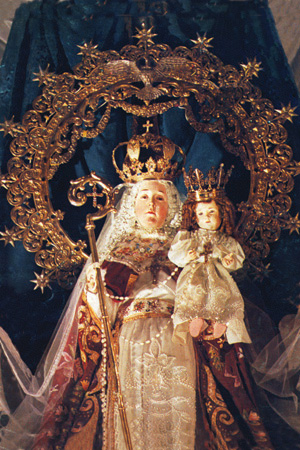
A devotion approved by the Church
for more than three centuries |
Answer: This is not a new apparition. It took place in the early 17th century. The revelations of Our Lady of Good Success and devotion to her miraculous Statue have been approved by the Catholic Church since the beginning. It was the 9th Bishop of Quito, Salvador de Ribera, who attested in official documents to the miraculous completion of the Statue by St. Francis of Assisi and the three Archangels – St. Michael, St. Gabriel and St. Raphael – and presided over the anointing of the solemn consecration of the Statue in the Church of the Royal Convent of the Immaculate Conception on February 2, 1611.
The devotion and apparitions were also authorized and promoted by the next Bishop of Quito, Pedro de Oviedo, who governed the Diocese from 1630 to 1646. Every Bishop since then - to the present Archishop - has approved the devotion and celebrated the feast of Our Lady of Good Success.
In 1991, the Archibishop of Quito petitioned Rome for a canonical coronation of Our Lady of Good Success as Queen of Quito, a ceremony that took place on February 2.
Further, in August 1986 Archbishop Antonio J. Gonzales issued an episcopal decree to intiatie the Casue of Beatification of Mother Mariana de Jesus Torres. The Admirable Life of Mother Mariana by Fr. Manuel Sousa Pereira was used as evidence of her sanctity. This decree affirmed that Mother Mariana had practiced all the virtues to a heroic degree and acknowledged her supernatural gifts and charismas.
Therefore, this devotion has enjoyed the support and approval of the Church since the time of Mother Mariana. There is no question that it is is "new" or "unapproved" devotion.
Question 2: What do these revelations talk about?
Answer: Many of the prophecies of Our Lady of Good Success have already been fulfilled. She predicted the proclamation of the dogmas of the Immaculate Conception and Papal Infallibility, the consecration of that country to the Sacred Heart of Jesus, the martyrdom of a Catholic president of Ecuador by Masons, and many others things that have come to pass. Msgr. Luis E. Cadena Y Almeida, postulator of the cause for beatification of the Servant of God, Mother Mariana de Jesus Torres, has written a book (in Spanish) on the many prophetic messages that have already taken place.
The most important prophecies of Our Lady of Good Success, however, spoke of the worldwide crisis in the Church and society that would begin in the 19th century and extend throughout the 20th century. During that time, she warned, there would be an almost total corruption of customs and Satan would rule almost completely by means of the Masonic sects. In the Catholic Church the Sacraments would be profaned and abused, and the light of Faith would be almost completely extinguished in souls. Truly religious souls would be reduced to a small number and many vocations would perish. Great impurity would reign and people would be without any care for spiritual matters. You can read about these prophecies in detail in the book Our Lady of Good Success: Prophecies for Our Times.
Our Lady told Mother Mariana, the religious Conceptionist who received the revelations, that the souls who would remain faithful in those difficult times would need great strength of will, constancy, valor and confidence in God. Moments would come when everything would seem to be lost and paralyzed, but that would be the moment, she promised, of the “happy beginning of the complete restoration.” “My hour will arrive” she foretold, “when I, in an amazing manner, will overthrow proud Satan, crushing him under my feet, chaining him in the infernal abyss, leaving the Church and the land free of this cruel tyranny.”
Even though the message of Our Lady of Good Success is very grave, it is also one of great hope.
Question 3: Who was Mother Mariana de Jesus Torres, the sister who received those revelations?
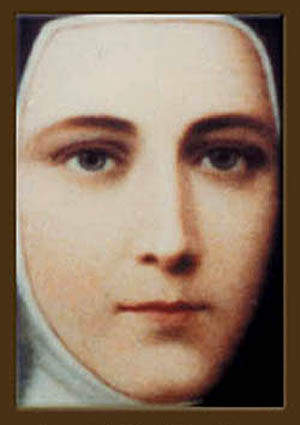
Mother Mariana de Jesus Torres
(1563-1635) |
Answer: Mother Mariana de Jesus Torres (1563-1635) was a Spanish Conceptionist sister who traveled from her country to the New World to help to found the Royal Convent. The life of Mother Mariana was truly extraordinary. The number of visions and mystical favors granted to her as well as the miracles worked through her intercession are numerous.
During her live, she was the superior of the Convent three times. During her first term as Abbess, she suffered persecutions from a group of rebellious nuns who wanted to relax the Rule. The rebellion grew, and the “inobservant” sisters put Mother Mariana and the other Spanish Founding Mothers in the Convent prison. Mother Mariana accepted all this and agreed to Our Lord’s condition to suffer the torments of Hell for five years in order to obtain the conversion of the leader of those rebellious sisters.
One of the most extraordinary facts of her life was a mystical-physical phenomenon: her several deaths and resurrections. Documented records from the Convent and Diocesan archives show that this truly holy religious died three times. Her first death was in 1582. Standing before the Judgment Seat, she was judged blameless and given a choice: to remain in celestial glory in Heaven or to return to earth to suffer as an expiatory victim for the sins of the 20th century. She chose the latter.
Her second death was on Good Friday of 1588 after an apparition where she was shown the horrible abuses and heresies that would exist in the Church in our times. She was resurrected two days later on Easter Sunday morning.
She finally died on January 16, 1635. Miracles worked through her intercession immediately followed.
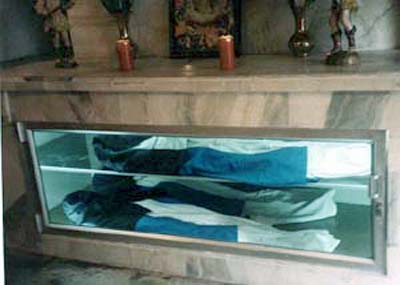
The body of Mother Mariana de Jesus Torres and another Founding Mother in the lower level of the cloisters |
The cause of her beatification was initiated by Archbishop of Quito Antonio J. Gonzales on August 8, 1986. He named Msgr. Luis Cadena y Almeida as postulator for the cause and established an ecclesiastical tribunal to begin the first phase of the process. He also issued a decree affirming that Mother Mariana had practiced all the virtues to a heroic degree and acknowledging her supernatural gifts and charismas during her lifetime. In 1906 during the remodeling of the Convent, the sarcophagus in which she had been buried in 1635 was opened and her body was discovered, whole and incorrupt. Today it is preserved in the lower level of the cloistered Convent.
Question 4: Why haven’t I heard of these apparitions until recently?
Answer: It can seem strange that such an important devotion has been almost unknown outside of Ecuador for so long a time. But there is a supernatural explanation for this. The Mother of God told Mother Mariana various times that only after three centuries of mysterious silence would the message of the apparitions become known. Our Lady linked the spread of this devotion to a miraculous and extraordinary intervention she would make for the restoration of the Catholic Church when the crisis would be so great that almost all would seem lost. Our Lady also promised to give her good success to those who had recourse to her under this invocation during these difficult times. Thus, in a very special way, this prophecy is for our days.
Question 5: What is the origin of the invocation?
Answer: In 1607 Pope Paul V gave the name Virgin of Good Success to a statue miraculously found by two Spanish Brothers of the Order of Minims for the Service of the Sick. After the death of Brother Bernandine de Obregón, its founder, Gabriel de Fontaned was elected his successor. Accompanied by Guillermo de Rigosa, the new Superior set off for Rome to plead the case for official approval of their Order before the Roman Pontiff. As they were passing through the town of Traigueras (in Catalonia), they were caught in a storm so severe it made them fear for their lives.
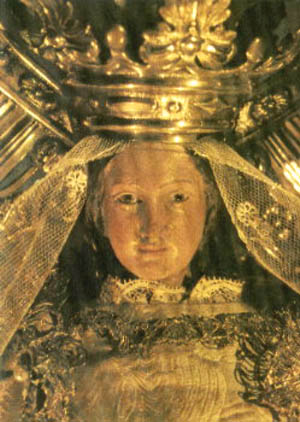
The original statue is in Madrid |
In their fear, they prayed to Our Lady for shelter and succor. Seeing a soft light in the distant mountains, they left the path and climbed toward it. They found a cave carved like a polished stone and fragrant with flowers that enshrined a very beautiful statue of Holy Mary carrying her Divine Son in her left arm, a scepter in her right, and a precious crown on her head. The dress was simple but elegant. They fell to their knees to venerate the beautiful statue, and wondered how she came to be in this distant place.
The next day they traveled to the closest hamlets to make inquiries. None of the inhabitants, not even the eldest who knew the history of everyone and everything in the area, had every heard of the cave or the statue. Thus, the Brothers became the owners of the holy statue, offering her their warmest thanks and choosing her as their special patroness. With this amiable and powerful companion, they continued on their journey to Rome.
Arriving there, they told the Sovereign Pontiff what had happened, and Pope Paul V not only acknowledged the supernatural nature of that discovery, but upon confirming the new Order, he placed it under the protection of the same Virgin, whom he gave the name of the Virgin of Good Success.
The statue was placed in the Royal Hospital of Madrid, and soon became famous for the numerous favors granted by Heaven through it. In 1641 King Philip III ordered the construction of the splendid sanctuary in the Puerta del Sol in Madrid. With the passing of time as the devotion spread, the statue was copied and placed in various places, sometimes under a different invocation. Today there are a number of localities in Spain where this image is venerated: Orduña, La Puebla de Gordon, Tudela, Abla, among others.
The invocation was not long in making its way across the ocean to the New World. The Blessed Virgin deigned to favor the Convent of the Immaculate Conception in Quito in a very special way by means of this particular avocation. In an apparition to Mother Mariana de Jesus Torres, the Blessed Virgin appeared and asked that a statue be made of her under the title of Good Success. She should be made just as she appeared to her there, with the Child Jesus in her right arm, and the Abbess’ crozier and the keys of the Convent in her right hand. She should be placed above the Abbess chair in the upper choir because she desired to be Abbess of that Convent until the end of time. And so the Virgin of Good Success of Quito appears with the crosier in her right hand, instead of the scepter that she carries in Madrid.
The Sisters of the Convent of the Immaculate Conception of Quito have always had a great love for their heavenly Abbess. The Statue of the Virgin of Good Success has been loved and venerated by the people of Quito for almost three centuries.
Question 6: How is the devotion spreading today?
Answer: Today the fame of this apparition is extending far beyond Quito. Our Lady of Good Success told Mother Mariana that she wanted to be known and loved throughout the world, and that the devotion would begin to spread only in the 20th century. This is, in fact, what has happened. She reserved this devotion for these times because the Church would be so embattled and suffering that only the divine power and love of the Blessed Virgin would sustain the faithful.
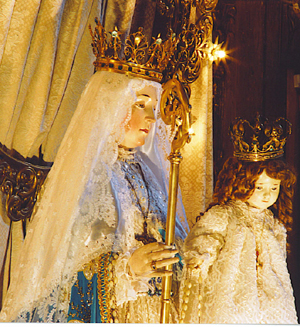
The Statue of the Infant Jesus is not the original |
Question 7: The Statue of the Infant Jesus does not seem to be the same quality as that of the Virgin Mary. Why is that, if both were miraculously completed by the Archangels and St. Francis of Assisi?
Answer: You are right about the difference. The Statue of the Divine Infant we see today in the arm of Our Lady of Good Success is not the original statue. The original, according to descriptions of the time, was the worthy match of the perfect and majestic Statue of Our Lady. During a revolution in Quito, a Sister hid the statue of the Infant along with some important documents from the Convent archives in a wall of the building. The Sister died a short time afterward without revealing the location where the objects were hidden. To replace the lost one, another statue of the Child was made, which does not achieve the same perfection as the first. According to the prophecy made by Mother Mariana, the original statue will be found, but only after the present crisis has ended and the restoration of the Holy Church has begun.
Question 8: Is this devotion the same as Our Lady of Sorrows in Quito?
Answer: No, it is different from the better known devotion to Mater Dolorosa, at times called Our Lady of Quito. At times various publications have confused the picture of Our Lady of Quito with the statue of Our Lady of Good Success.
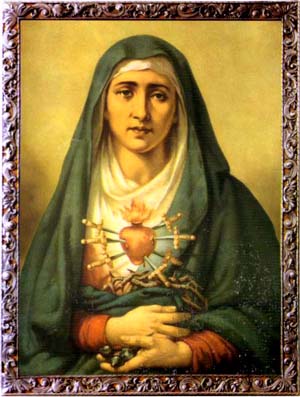
Mater Dolorosa, Our Lady of Quito |
The picture of Our Lady of Quito, an image of Our Lady with the seven swords piercing her heart, was first placed in the boarding school of the Jesuit Fathers in Quito. On April 20, 1906, Father Andrew Roesch along with 36 boys of the academy witnessed the first miracle of this famous picture. While in the refectory they saw the Blessed Mother slowly open and shut her eyes. The same miracle occurred several times after this.
The canonical process of examination was carried out by the ecclesiastical authorities, and the Vicar General ordered the picture to be transferred in procession from the College to the Church of the Jesuit Fathers in the downtown plaza, not far from the Conceptionist Convent. At the Church of the Jesuits, the prodigy was repeated many times, and many conversions took place. In Quito this image is known as the Mater Dolorosa del Colegio [Sorrowful Mother of the College].
On the 50th anniversary of the first miracle, His Holiness Pope Pius XII ordered the Canonical Coronation of the miraculous image of Our Sorrowful Mother, declaring her Queen of the Catholic Education in Ecuador.
Therefore, the devotion to Our Lady of Sorrows is not the same at that of Our Lady of Good Success.
Question 9: What is meant by the words “good success”? In English, it can give the impression that one is asking for material success.
Answer: That is not the original Spanish connotation. The invocation of “good success” refers to the happy development of the gestation of Christ from the Conception to Birth. The invocation of “good success” was understood by the faithful in its first meaning as a simple plea for safe childbirth. This easily extended to the invocation of Mary's meditation and intercession in times of personal need (sickness, travel, marriage).
The expression later broadened further to be understood in the sense of good success in various undertakings. For example, its popularity in the seafaring regions of Catalonia, Isle of Gomera, and Granada indicates a connection with maritime travel. Sailors would ask Mary for a safe return to port. The extended meaning can also be that of a holy death. In short, sucesso, meaning success or luck, refers to well-being and safety where strictly human means find no issue.
A meaning for our times that refers to the first signification is pointed out by Atila Guimarães in his introduction to my book Our Lady of Good Success: Prophecies for Our Times. He noted that the invocation could be said to have extended even further with the revelation of Quito:
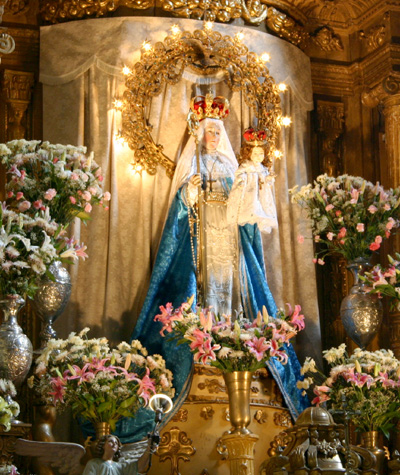
Our Lady of Good Success displayed for public veneration over the main altar of the Convent Church |
“There, at the beginning of the 17th century, Our Lady came to ‘conceive’ a new era for her glory, an era that would be born much later. The ‘good success,’ therefore, speaks of the broad Marian protection she would give to the Holy Church during this time and of the happy establishment of the new era that will come. It is an invocation that relates to the future.”
Question 10: When can the public see the miraculous Statue of Our Lady of Good Success?
Answer: The miraculous Statue of Our Lady of Good Success is taken from the cloistered upper choir three times a year and placed above the main altar of the Convent Church, so that it can be venerated by the people of Quito. It can be seen by the public at the following times:
1. During a nine-day novena in commemoration of the Feast Day of the Purification of Our Lady (February 2) – from around January 24 to February 4;
2. During the month of May;
3. During the month of October.
Question 11: Why does Our Lady of Good Success carry a scepter with the staff pointing inward?
Answer:
Our Lady of Good Success told Mother Mariana that she wanted to act as Abbess of the Monastery of the Immaculate Conception until the end of time, and that she desired to be portrayed as such.
As a rule the Abbess, like the Abbot, is inducted in her office with the crosier (staff), ring and keys of the abbey at the formal installation ceremony. She carries the crosier in her right hand as a symbol of her office and of her rank. Like the abbot’s or prelate’s staff, the top is curved to symbolize her submission to the Supreme Vicar of Christ, the Pope. Unlike the Bishop, who carries his crosier pointing outward to symbolize his jurisdiction over the external world, she generally carries it pointing inward, a symbol that she exercises supreme domestic authority (potestas dominativa) inside her monastery and all its dependencies. At the same time, Abbesses have no spiritual jurisdiction, and can exercise no authority that is in any way connected with the power of the keys or of orders.
When Our Lady ordered Mother Mariana to have the statue made in 1599, she gave her detailed instructions on how she should appear, with the Divine Infant in her left arm and the crosier in her right hand, just as she appeared to her then. Because of her special love for this chosen Convent in Ecuador, she told her she desired to wear the symbols of the Abbess and be placed on the Abbess chair in the upper choir of the cloisters to govern that Convent until the end of time.
She explained that Our Lord desired that this statue be made for two reasons: first, for the people of the city of Quito and the whole world so they might have recourse to her in the difficult days ahead; second, so that throughout time her daughters in the Convent should come to her as their Mother and Abbess. Therefore, her crosier points outward, indicating an authority extending beyond the walls of the Convent.
On February 2, 1611 the Bishop of the Spanish Colony of Quito at that time, Bishop Salvador de Ribera, formally blessed the miraculous statue and delivered to her the keys of the Convent, which he had ordered made at his own expense. He then reverently placed the crosier in her right hand, saying, “My Lady, I deliver to thee the government of this Convent and of my flock in general.”
Since that time, devotion to Our Lady of Good Success has been approved by the Bishops of Quito up to our times. In 1991 the Archdiocese of Quito petitioned Rome for a canonical coronation of Our Lady of Good Success as Queen of Quito, recognition of her authority over the city. That ceremony took place on February 2, 1991.

Posted December 29, 2002
|

Related Works of Interest
|
Our Lady Good Success | Home | Books | CDs | Search | Contact Us | Donate

© 2002- Tradition in Action, Inc. All Rights Reserved
|
 |
|